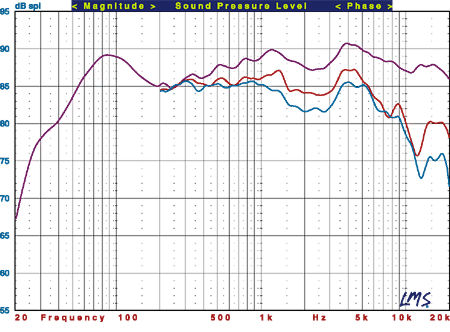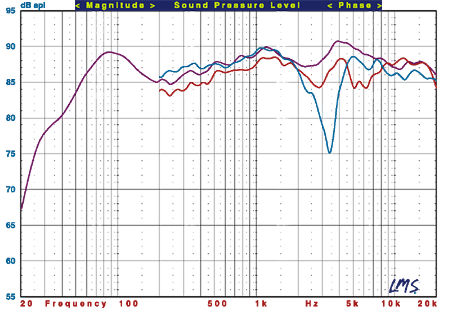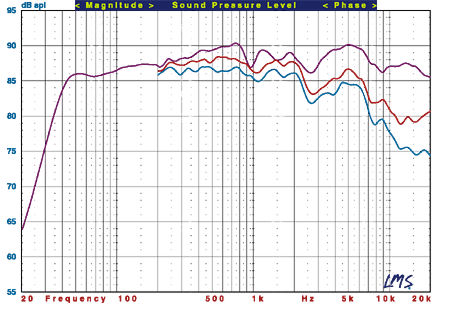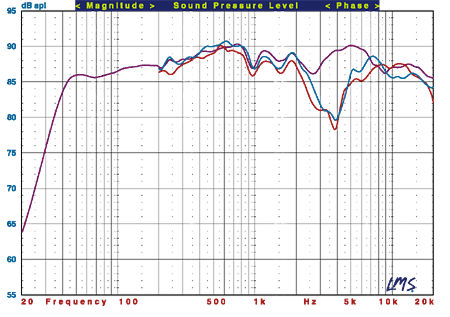B&W 703, HTM7, 705, ASW750 surround speaker system Measurements
The B&W 703's ported enclosure is tuned to approximately 32Hz, and its minimum impedance is 2.8ohms at 100Hz. The impedance remains below 4ohms from about 79Hz to 400Hz—a region of the frequency spectrum that is dense with fundamentals and requires more of an amplifier, over time, than even the deep bass (which makes huge but less constant demands). I would judge this speaker to be moderately difficult to drive. For that reason, I would conservatively rate its nominal impedance at 4ohms. The 703's sensitivity measured about 88dB/2.83V/m.
The 703's horizontal front response is shown in Fig.1 (violet). This is the pseudo-anechoic response averaged over a 30° forward horizontal angle (+/-15°) at tweeter height, combined with the nearfield responses of the woofer and port. The effective lower limit of the speaker was 36Hz (–10dB).

Fig.1: B&W 703, pseudo-anechoic response at 45° (red) and 60° (blue) off horizontal axis.
The averaged front horizontal response of the 703 falls within a window of about +/-3dB from 55Hz to 20kHz. There is a slight leaning-out of the response below 1kHz. The response is consistent with my early subjective impressions of a slight treble prominence. Specifically, the dip and bump at 2.5kHz and 4kHz, respectively, combined with the slightly lean midbass, would produce such a balance. The upper treble is a bit down in level compared to the region just below it, but it's very smooth.
Measurements made with and without the grilles showed little change in the response. (All measurements shown here were made with the bass/midrange grilles off and the tweeter grilles on.) The speaker's off-axis performance is actually a little flatter overall, apart from the expected rolloff at high frequencies.
The vertical response shown in Fig.2 indicates that the 703 should sound best when the listener's ears are positioned just a little above the tweeter axis.

Fig.2: B&W 703, pseudo-anechoic response at 15° above (red) and 15° below (blue) tweeter.
The HTM7 center-channel's cabinet is tuned to about 46Hz, and its minimum impedance is 5.1ohms at 230Hz. This will be a relatively easy load to drive; I conservatively rate its nominal impedance at 6ohms. The HTM7's sensitivity measured approximately 88dB/2.83V/m.
The HTM7's measured front horizontal response, taken on the tweeter axis and averaged in the same manner as described above for the 703, is shown in Fig.3. The speaker's effective lower limit (–10dB) is approximately 36Hz referenced to the level at 1kHz. Surpris-ingly, this is the same lower limit we measured for the 703, though the larger speaker should be able to play far louder and with less distortion at this frequency.

Fig.3: B&W HTM7, pseudo-anechoic response at 45° (red) and 60° (blue) off horizontal axis.
The measured frequency response of the HTM7 is roughly similar to that of the 703 above 1kHz, and a little leaner at low frequencies. It actually falls within a somewhat tighter window, the averaged front response (+/-15°) measuring +/-2.5dB from about 42Hz to 20kHz. More significant, the vertical orientation of the drivers avoids the nemesis of so many 2-way center-channel speakers: the dreaded off-axis suckout. Even at extreme off-axis angles, there are no dips in the response of the sort we invariably see in speakers that use horizontally configured woofers and tweeters.
The HTM7's vertical off-axis response (Fig.4), however, suggests that you should listen quite close to tweeter height, or tilt the speaker toward the listening position.

Fig.4: B&W HTM7, pseudo-anechoic response at 15° above (red) and 15° below (blue) tweeter.
Overall, this is a solid set of measurements for a speaker system at this price.—TJN
All figures: Violet curve: pseudo-anechoic response on tweeter axis, averaged across a 30° horizontal window, combined with nearfield woofer and port responses. All measurements taken at 1m.
























































